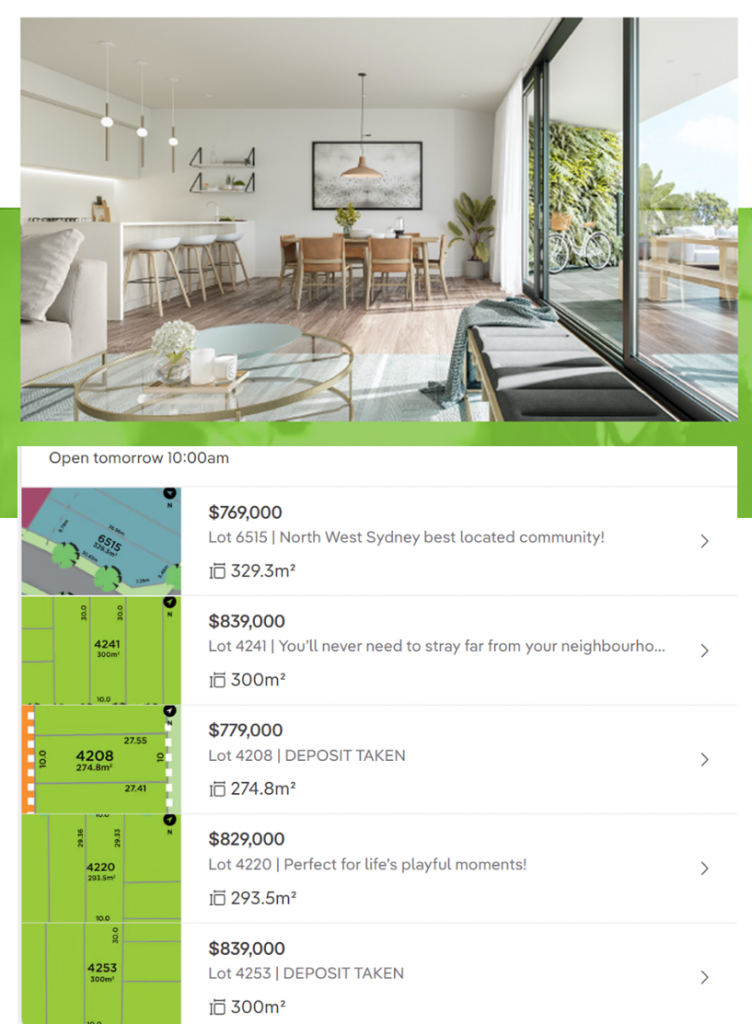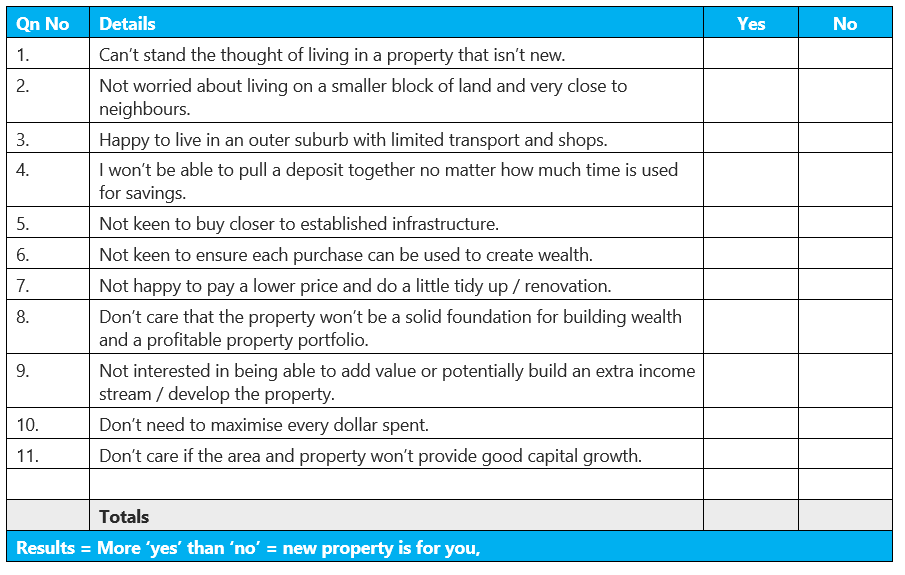The Truth About Existing v New Property

Congratulations. You’re ready to make your property purchase. So what’s it going to be – an existing property or will you buy new? If you’re focused on a new property, are you buying off the plan, a house and land package, or just recently built? Lucky you . .so many options.
The ‘existing v new’ issue is one of the key decisions we help our clients make, and there’s a few aspects to consider before you can settle on a choice.
Positives and negatives
Outlined below is a summary of the positives and negatives for both cases.

Depreciation
If you’re purchasing an investment property, one of the common topics in the ‘new versus existing’ debate is depreciation. Put simply, depreciation is the tax deduction investors can claim to reflect the wear and tear of a property’s building and fixtures over time.
Many advisers promote depreciation as a major selling point for new property. While it can deliver attractive tax benefits in the short term, it’s important to approach with caution. Depreciation should never be the sole reason for a purchase, because any tax advantages gained must be paid back when the property is sold. This fact is often left out of the sales pitch.
The Benefits
- Tax savings: Depreciation reduces taxable income, which can lower the investor’s tax bill.
- Cash flow support: For high-income earners, deductions can improve cash flow, making holding the property easier.
- Coverage for both new and existing properties: Although new builds usually qualify for higher building depreciation (under Division 43), older properties can still attract depreciation on fixtures, fittings, and even renovations completed by previous owners.
The Drawbacks
- Deferred tax, not free money: Any benefit gained through depreciation is generally added back when you sell, reducing your capital gains tax discount.
- Distorted decision making: Investors may be tempted to buy new property purely for tax deductions, overlooking fundamentals like location, growth potential, or rental demand.
- Complexity: The rules differ between Division 43 (building costs) and Division 40 (fixtures and fittings), and not all properties qualify in the same way.
A Balanced View
Depreciation can be a useful bonus, but it shouldn’t drive your investment decision. Older properties can still offer strong growth and rental returns, while also providing depreciation opportunities on renovations and fittings. New properties may deliver larger upfront deductions but can come with other risks, such as inflated pricing or limited capital growth.
As with most financial strategies, the right approach depends on your personal circumstances, income position, and investment goals. A qualified accountant or property professional can help you weigh the real value of depreciation against the broader performance of the property.
Important differences
In the majority of cases, new property – no matter how much depreciation can be loaded into the ‘deal’ – will never be able to deliver the range of outcomes you can achieve with a good ‘established’ property purchase.
This is because an established property will usually have a lower purchase price (when compared with a new property), bigger block size, along with potential to freshen up / renovate / add granny flat / develop.
Established properties will be located near established infrastructure such as transport, shopping centres, schools and sporting centres, while new property will typically be located on the outskirts of cities far from shops and entertainment.
Crucially, you will be able to walk through an established property as opposed to looking at a model home – which will often include all the expensive upgrades – or looking at plans, and you will be able to rent out an established property immediately rather than waiting months for the property to be built.
Grants and exemptions
A key attraction with new property is the range of Federal and State grants and stamp duty exemptions on offer. In addition, in new estates builders need to compete to attract buyers and will often include purchase packages to sweeten the deal.
This leads many buyers to be trapped by the heavy marketing of new property resulting in purchases that will never deliver on the marketers’ promises. Even worse, many property prices have been inflated to match the grants and exemptions, so the benefits fall into everyone else’s pocket but yours.
In order to ensure you’re not over-paying for a property, compare any purchases on offer using the nett price method. This involves deleting the total amount of grants and exemptions from the asking price. For example, where grants and exemptions total $40,000, deleted from an asking price of $700,000 means the real price is $660,000.
Conduct comparisons
Using the nett price method will help you compare the real price against properties where the grants don’t apply. For example, you may be able to purchase a good quality existing property in a well located suburb for $650,000. The grants may not apply, but you won’t need as much of a deposit and the stamp duty exemptions may still be achieved.

By way of example, the advert above is selling apartments in a development located in a new outer suburb of Sydney. Note they haven’t included the strata fees or other ongoing costs of the apartments but the apartments are priced from $650,000 for a one bedroom through to more than $1,000,000 for 3 bedrooms. And . . remember that apartments have extremely limited opportunity to add value or attract a higher price for rental over the other properties in the same complex.
Also the prices listed of $769,000 to $839,000 just for land will be enough to purchase a house in a range of established suburbs closer to transport, shops and other amenities. Further benefits include good capital growth, numerous opportunities to add value, along with immediate rental returns.
If you’re still trying to decide between existing or new properties, use the decision tool below for further insights.

Key facts
Fact = New properties quickly drop in value because they lose their key feature of being ‘new’ as soon as they are purchased. In this way, new property works in the same way as a new car – it loses a large amount of value as soon as it purchased.
Fact = New properties are usually built amidst hundreds of other new properties so it’s actually harder to achieve a price increase. Capital growth will be non-existent if a property is located in a new area surrounded by.lots of greenfield space or acreage that is planned for development. This is because more ‘stock’ / other properties will mean more property is available. Good capital growth is achieved in established areas where there is limited supply of properties available to purchase or rent.
Fact = Poor standards of building quality means new properties are currently deteriorating at a greater pace than established properties. This is not only due to the quality of the builder, but also the quality of the building materials used.
Fact = Critically for investment properties, established properties can be rented out immediately and are better located which means investors can start making money immediately upon settlement. New properties will often need 9 – 12 months to be built and by then investors will have more rental competition as they’re competing with other new builds.
The truth
The truth is that your choice between existing or new property will depend on what you need in your next purchase, as well as what suits your interests, budget, style and skills. Can you afford a new property, or is your budget better suited to an existing property with existing tenants? Do you want to design your own home, rather than re-model an existing property?
If you aren’t sure what works best for you, we’re happy to discuss the possibilities. After your preferences are clear, this should clarify the best location for you. In this way, you will be the master of your own selections instead of what someone else wants to sell you.
About the Author
Debra Beck-Mewing is the CEO of The Property Frontline and Editor of Property Portfolio Magazine. With over 20 years of experience buying property across Australia, Debra is a skilled property strategist and buyers agent known for uncovering tailored opportunities — from family homes to multi-use investments.
She has deep expertise in advanced strategies including renovations, granny flats, sub-division, and development. A Qualified Property Investment Advisor (QPIA®), licensed real estate agent, and holder of a Bachelor of Commerce and Master of Business, Debra combines strategic insight with hands-on experience.
Debra is the creator of the Buyer Success Program™ – Australia’s only interactive, in-the-moment support system for property buyers, designed to help everyday Australians cut through the chaos and buy with confidence. She also leads Buy Like A Genius™, a premium end-to-end buyers’ agency service for busy professionals seeking expert property acquisition without the stress.
As a passionate advocate for greater transparency in the property and wealth industries, Debra is a sought-after speaker, author, podcast host, and participates on numerous committees including the Property Owners’ Association.
Download your guide
Start Buying - Stop Crying
There’s plenty of opportunities if you’re trying to buy a property in the current market, and the news gets better if you qualify for financial assistance packages.
DON'T GUESS, STRESS OR OVERPAY
Learn how to turn the market in your favour no matter where it heads next, by using the tips included in our guide.
We hate SPAM. We will never sell your information, for any reason.










